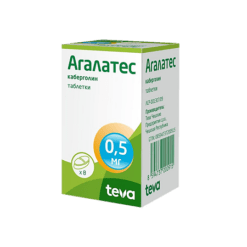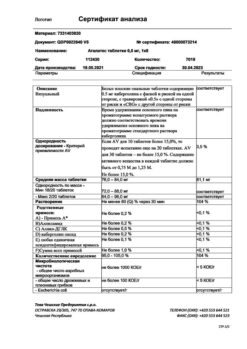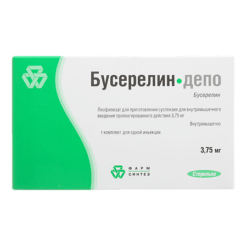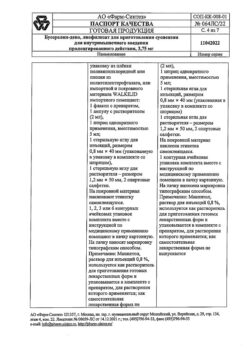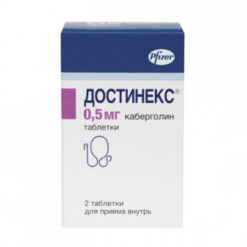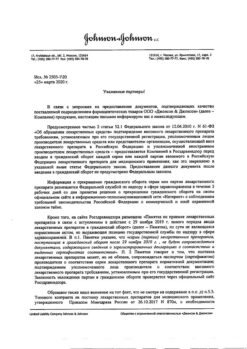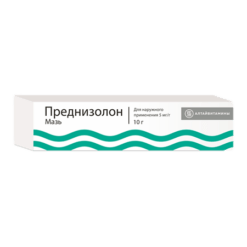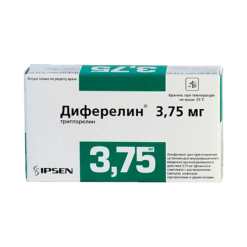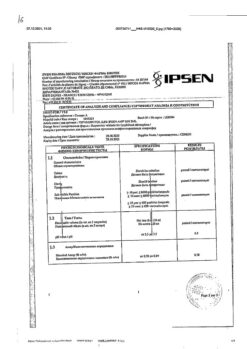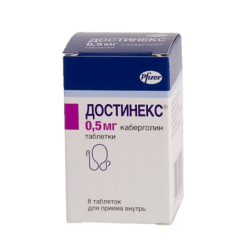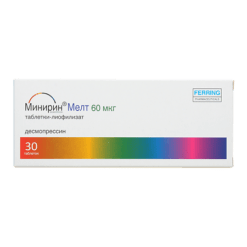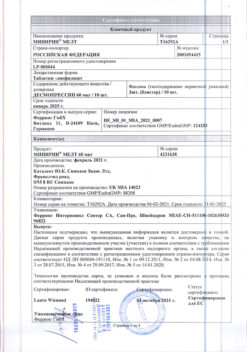No products in the cart.
Minirin Melt, 120 mcg 30 pcs
€81.38 €70.53
Description
Pharmacodynamics:
Minirin® Melt contains desmopressin, a structural analog of the natural peptide hormone of the hypothalamus, arginine vasopressin, derived from changes in the structure of the vasopressin molecule. The difference consists in the deamination of cysteine (in the 1st position) and replacement of L-arginine (in the 8th position) by D-arginine. This leads to a significant prolongation of antidiuretic action and complete absence of action on vascular and internal smooth muscle compared to native arginine vasopressin.
Desmopressin increases permeability of distal tubule epithelium and increases water reabsorption, resulting in decrease of urine output, increase of urine osmolarity with simultaneous decrease of blood plasma osmolarity, decrease of frequency of urination and decrease of nocturia (nocturnal polyuria).
Clinical studies
Clinical studies of Minirin® Melt, lyophilizate tablets, for the treatment of nocturia showed the following results:
There was a 50% reduction in nocturnal urinary frequency in 39% of patients taking desmopressin compared with 5% of patients in the placebo group (p&p<0.0001) ;
– the mean number of urges to urinate at night was reduced by 44% in the desmopressin group and by 15% in the placebo group (p&p<0.0001);
the mean duration of the first period of sleep was increased by 64% in the patients taking desmopressin compared to 20% in the placebo group (p<0.0001);
The mean initial sleep time increased by 2 hours in the desmopressin group and by 31 minutes in the placebo group (p<0.0001).
Pharmacokinetics:
Absorption and distribution
The maximum plasma concentration (Cmax) of desmopressin is reached within 0.5-2 h (Tmax) after sublingual administration of the drug and is directly proportional to the dose taken: After administration of 200, 400, and 800 mcg, the Tmax was 14 pg/mL, 30 pg/mL, and 65 pg/mL, respectively. Simultaneous intake of food may reduce the degree and rate of absorption by 40%. The bioavailability of desmopressin in sublingual form in doses of 200, 400 and 800 mcg is about 0.25%. Bioavailability may vary from patient to patient.
Desmopressin does not penetrate the blood-brain barrier.
Metabolism and excretion
In an in vitro liver microsome study, it was found that a small portion of desmopressin is metabolized in the liver. Based on the findings, it was concluded that the metabolism of desmopressin in the liver in vivo is not significant. Desmopressin is excreted by the kidneys with a half-life of 2.8 h.
Indications
Indications
– Diabetes insipidus of central origin;
– polyuria/polydipsia after hypophysectomy or operations in the sella region;
– primary nocturnal enuresis in adults and children over 5 years of age;
– nocturia in adults associated with nocturnal polyuria (increased urine production at night, exceeding the capacity of the bladder and causing the need to get up more than once at night to empty the bladder) – as symptomatic therapy.
Pharmacological effect
Pharmacological effect
Pharmacodynamics:
The drug Minirin® Melt contains desmopressin – a structural analogue of the natural peptide hormone of the hypothalamus, arginine vasopressin, obtained as a result of changes in the structure of the vasopressin molecule. The difference is the deamination of cysteine (in the 1st position) and the replacement of L-arginine (in the 8th position) with D-arginine. This leads to a significant prolongation of the antidiuretic effect and a complete lack of effect on the smooth muscles of blood vessels and internal organs compared to native arginine vasopressin.
Desmopressin increases the permeability of the epithelium of the distal convoluted tubules and increases water reabsorption, which leads to a decrease in the volume of urine excreted, an increase in urine osmolarity with a simultaneous decrease in blood plasma osmolarity, a decrease in the frequency of urination and a decrease in nocturia (nocturnal polyuria).
Clinical studies
Clinical studies of the drug Minirin® Melt, lyophilisate tablets, for the treatment of nocturia showed the following results:
– There was a 50% reduction in nighttime urinary frequency in 39% of patients taking desmopressin compared to 5% of patients taking placebo (p<0.0001) ;
– the average number of urges to urinate at night was reduced by 44% in the desmopressin group and by 15% in the placebo group (p<0.0001);
– the average duration of the first period of sleep increased by 64% in patients taking desmopressin, compared with 20% in patients in the placebo group (p<0.0001);
– the average time of initial sleep increased by 2 hours in the desmopressin group, by 31 minutes in the placebo group (p<0.0001).
Pharmacokinetics:
Absorption and distribution
The maximum concentration (Cmax) of desmopressin in the blood plasma is achieved within 0.5-2 hours (Tmax) after sublingual administration of the drug and is directly proportional to the dose taken: after using 200, 400 and 800 mcg, Cmax was 14 pg/ml, 30 pg/ml and 65 pg/ml, respectively. Concomitant food intake can reduce the degree and rate of absorption by 40%. The bioavailability of sublingual desmopressin in doses of 200, 400 and 800 mcg is approximately 0.25%. Bioavailability may vary between patients.
Desmopressin does not penetrate the blood-brain barrier.
Metabolism and excretion
When studying liver microsomes in vitro, it was found that a small part of desmopressin is metabolized in the liver. Based on the data obtained, it was concluded that the metabolism of desmopressin in the liver in vivo is not significant. Desmopressin is excreted by the kidneys, the half-life is 2.8 hours.
Special instructions
Special instructions
To avoid the development of side effects, it is imperative to limit fluid intake to a minimum 1 hour before use and for 8 hours after use of the drug in patients with primary nocturnal enuresis.
Failure to comply with the rules for taking the drug can cause fluid retention in the body and/or hyponatremia, which can be manifested by the following symptoms: headache, dizziness, nausea, vomiting, weight gain, in severe cases – cerebral edema, convulsions and coma.
The safety of the drug during long-term use in cases of nocturnal enuresis has not been studied.
To diagnose nocturnal polyuria in patients with nocturia, 2 days before the start of treatment, it is necessary to monitor the frequency and volume of urination. An increase in urine production at night that exceeds the capacity of the bladder or exceeds 1/3 of the daily urine volume is considered nocturnal polyuria.
When desmopressin was taken to treat nocturnal enuresis, cases of cerebral edema and seizures have been observed in healthy children and adolescents. Based on the available information, we can conclude that the risk of developing cerebral edema and seizures is highest in the first week of taking the drug.
Hyponatremia most often occurs in elderly patients (over 65 years of age) and in patients with initially low sodium concentrations.
The duration of action of the drug increases with increasing dose, leading to an increased risk of developing hyponatremia. Increasing the dose should be done with great caution.
The drug Minirin® Melt should be used with caution in patients with chronic renal failure, bladder fibrosis, cystic fibrosis, coronary heart disease, arterial hypertension, with a potential risk of increased intracranial pressure; violation of water-electrolyte balance; in patients at risk of developing thrombosis; during pregnancy, including preeclampsia; in elderly patients (over 65 years of age) when used for the treatment of diabetes insipidus.
Before starting to take the drug (and 3 days after starting or increasing the dose), patients over 65 years of age must determine the sodium content in the blood plasma.
If headache and/or nausea occurs, the drug should be discontinued.
Patients with arterial hypertension or chronic kidney disease may develop the symptoms listed in the “Side Effects” section.
Particular caution should be exercised when using Minirin® Melt in children and elderly patients or patients at risk of increased intracranial pressure, trying to prevent fluid retention in the body.
Failure to take the drug may cause fluid retention in the body and the development of hyponatremia.
Patients and, when using the drug in children, their parents should be informed of the need to limit fluid intake and stop taking desmopressin in case of vomiting, diarrhea, systemic infectious diseases and fever, and not to resume taking it until the water and electrolyte balance is normalized.
To reduce the risk of developing hyponatremia or fluid retention, you should reduce your fluid intake in the following cases:
– when taking medications that lead to the syndrome of inadequate production of antidiuretic hormone (tricyclic antidepressants, selective serotonin reuptake inhibitors, chlorpromazine, chlorpropamide and carbamazepine);
– with concomitant use of NSAIDs.
During treatment, changes in body weight should be monitored.
Before using the drug, organic causes of polyuria, increased urine volume or nocturia, including prostatic hyperplasia, urinary tract infections, nephrolithiasis, bladder tumors, bladder sphincter dysfunction, polydipsia or impaired glycemic control in diabetes, should be excluded, and if the above diseases are present, appropriate treatment should be carried out.
Before starting treatment, it is necessary to treat insufficiency of the adrenal cortex or thyroid gland.
Influence on the ability to drive transport. Wed and mech.:
Currently, there is no data on the possible effect of the drug Minirin® Melt on the ability to drive vehicles and operate machinery. However, the use of the drug can lead to the development of undesirable reactions such as dizziness, headache, which can negatively affect the ability to drive vehicles and perform potentially hazardous activities that require increased concentration and speed of psychomotor reactions.
It is recommended to exercise caution when driving vehicles or operating machinery.
Active ingredient
Active ingredient
Desmopressin
Composition
Composition
desmopressin 120 mcg, excipients: gelatin – 12.5 mg, mannitol – 10.25 mg, citric acid – up to pH 4.8 (0.12-0.35 mg).
Pregnancy
Pregnancy
Pregnancy
Despite the limited data on the use of desmopressin in pregnant women with diabetes insipidus (n=53), there were no negative effects on the course of pregnancy or on the health of the pregnant woman, fetus or newborn. Preclinical studies in animals did not reveal direct or indirect effects on pregnancy, intrauterine development, childbirth or postnatal development. However, the drug is prescribed only when the expected benefit to the mother outweighs the potential risk to the fetus. The dosage regimen of the drug during pregnancy should be adjusted taking into account the patient’s condition. Given the increased risk of developing preeclampsia, it is recommended to monitor blood pressure.
Breastfeeding period
A study of breast milk from women who received desmopressin at a dose of 300 mcg intranasally showed that the amount of desmopressin that can enter the child’s body is too small and is not able to affect its diuresis.
Contraindications
Contraindications
Hypersensitivity to desmopressin or other components of the drug;
– habitual or psychogenic polydipsia (with a urine output volume of 40 ml/kg/24 hours);
– known or suspected chronic heart failure and other conditions requiring diuretics;
– hyponatremia;
– moderate or severe renal failure (creatinine clearance (CC) below 50 ml/min);
– children under 5 years of age;
– age 65 years and older – when used for symptomatic treatment of nocturia;
– syndrome of inadequate production of antidiuretic hormone;
– polydipsia in chronic alcoholism.
With caution:
Renal failure (creatinine clearance more than 50 ml/min), bladder fibrosis, cystic fibrosis, coronary heart disease, arterial hypertension, water and electrolyte imbalance, potential risk of increased intracranial pressure, risk of thrombosis, pregnancy, incl. preeclampsia, old age (65 years and older) when used for the treatment of diabetes insipidus.
Side Effects
Side Effects
Use of the drug without concomitant restriction of fluid intake may lead to fluid retention and/or hyponatremia, which may be asymptomatic or accompanied by the following symptoms: headache, nausea and/or vomiting, weight gain; in severe cases – convulsions, which are combined with impaired consciousness up to prolonged loss of consciousness. These symptoms are especially common in children under one year of age or the elderly, depending on their general condition.
Frequency of side effects: very common (≥ 1/10), common (≥ 1/100 to < 1/10), uncommon (≥ 1/1000 to < 1/100), rare (≥ 1/10000 to < 1/1000), very rare (< 1/10000), frequency not established (currently there are no data on the prevalence of adverse reactions, identified during post-registration use of the drug Minirin® Melt).
Adults:
The table shows adverse reactions and the frequency of their occurrence based on data obtained during a clinical trial in patients with nocturia (N=1557) and during post-registration use of the drug for all indications for use (including diabetes insipidus).
System-organ class
Very often
Often
Infrequently
Rarely
Frequency not set
Immune system disorders
Anaphylactic reactions
Metabolic and nutritional disorders
Hyponatremia
Dehydration*, hypernatremia*
Mental disorders
Insomnia
Confusion
Nervous system disorders
Headache
Dizziness
Drowsiness, paresthesia
Convulsions, asthenia*, coma
Vision disorders
Decreased visual acuity
Hearing and labyrinthine disorders
Vertigo
Heart disorders
Feeling of heartbeat
Vascular disorders
Arterial
hypertension
Orthostatic hypotension
Disorders of the respiratory system, chest and mediastinal organs
Shortness of breath
Gastrointestinal tract disorders
Nausea, abdominal pain, diarrhea, constipation, vomiting
Dyspepsia, flatulence, bloating
Skin and subcutaneous tissue disorders
Increased sweating, itching, skin rash, urticaria
Allergic dermatitis
Musculoskeletal and connective tissue disorders
Muscle spasms, myalgia
Disorders of the kidneys and urinary tract
Bladder dysfunction, urinary dysfunction
general disorders and disorders at the injection site
peripheral edema, feeling of fatigue
feeling of discomfort, chest pain, flu-like syndrome
laboratory and instrumental data
increase in body weight, increased activity of liver enzymes, hypokalemia
*adverse reactions were observed only in patients with diabetes insipidus.
children
The table shows adverse reactions and the frequency of their occurrence based on data obtained during a clinical trial (n=1923) and during post-registration use of the drug Minirin® melt for the treatment of primary nocturnal enuresis in children.
systemic organ class
very often
often
rarely
rarely
frequency not set
immune system disorders
anaphylactic reactions
metabolic and nutritional disorders
hyponatremia
mental disorders
emotional lability, manifestation of aggression
anxiety, nightmares, sudden mood swings
behavior changes, emotional disturbances, depression, hallucinations, insomnia
nervous system disorders
headache
drowsiness
attention disturbance, psychomotor hyperactivity, convulsions
vascular disorders
arterial hypertension
disorders of the respiratory system, chest and mediastinal organs
nosebleed
gastrointestinal tract disorders
stomach pain, nausea, vomiting, diarrhea
disorders of the skin and subcutaneous tissue
allergic dermatitis, skin rash, increased sweating, urticaria
renal and urinary tract disorders
bladder dysfunction, urinary dysfunction
general disorders and disorders at the injection site
peripheral edema, feeling of fatigue
irritability
attention! Desmopressin may have an antidiuretic effect. Taking Minirin® melt, lyophilisate tablets, without simultaneous restriction of fluid intake can lead to fluid retention in the body, accompanied by hyponatremia, manifested by headache, abdominal pain, nausea, vomiting, weight gain, dizziness, confusion, malaise and, in severe cases, can lead to seizures, cerebral edema and coma.
In particular, the risk of developing the above complications is highest in children under 1 year of age or in elderly patients (over 65 years of age), depending on their general health. When treating nocturia in adults, hyponatremia often develops at the beginning of taking the drug or when the dose is increased. hyponatremia is reversible. When taking the drug Minirin® melt, it is necessary to monitor the water and electrolyte balance.
during treatment, arterial hypertension may develop due to fluid retention. Patients with coronary heart disease may develop angina.
if any of the adverse reactions indicated in the instructions worsen, or you notice any other adverse reactions not listed in the instructions, tell your doctor.
Interaction
Interaction
With simultaneous use of clofibrate, indomethacin and other non-steroidal anti-inflammatory drugs (NSAIDs), tricyclic antidepressants, selective serotonin reuptake inhibitors, chlorpromazine, chlorpropamide, carbamazepine and other drugs that can cause the syndrome of inappropriate secretion of antidiuretic hormone, may enhance the antidiuretic effect of desmopressin and lead to an increased risk of fluid retention and hyponatremia. When taking desmopressin concomitantly with the above drugs, it is necessary to carefully monitor blood pressure, plasma sodium concentration and urine volume.
When using desmopressin with loperamide, a threefold increase in the concentration of desmopressin in plasma is possible, which significantly increases the risk of fluid retention and the occurrence of hyponatremia.
It is possible that other drugs that reduce the tone and motility of intestinal smooth muscles may have a similar effect.
Concomitant use with oxytocin may increase the antidiuretic effect of desmopressin and reduce uterine perfusion.
When using the drug Minirin® Melt simultaneously with the above drugs to prevent the development of hyponatremia, it is necessary to carefully monitor blood pressure, sodium concentration in the blood plasma and urine volume.
Taking glibenclamide and lithium drugs may reduce the antidiuretic effect of desmopressin.
Interactions with drugs metabolized by the liver are unlikely as desmopressin does not have a significant effect on hepatic metabolism based on in vitro liver microsome studies. No in vivo studies have been conducted.
Overdose
Overdose
Overdose symptoms
Symptoms of overdose may occur if the dose of desmopressin is too high or if excessive fluid intake is taken at the same time or shortly after taking desmopressin.
Overdose symptoms: weight gain due to fluid retention, headache, nausea, in severe cases – overhydration (water intoxication), accompanied by convulsions, confusion or loss of consciousness.
Overdose can occur in children at an early age due to insufficiently careful dose selection.
Treatment
In case of overdose, depending on its severity, you should reduce the dose of the drug, increase the time between taking the drug during the day, or stop taking the drug.
If cerebral edema is suspected, immediate hospitalization in the intensive care unit is necessary.
If seizures occur, immediate intensive care is required.
A specific antidote for desmopressin is not known.
To induce diuresis, it is possible to use diuretics, such as furosemide, while simultaneously monitoring the content of electrolytes in the blood plasma.
Storage conditions
Storage conditions
At a temperature not exceeding 25 °C, in the original packaging.
Keep out of the reach of children.
Shelf life
Shelf life
4 years.
Do not use after the expiration date stated on the package.
Manufacturer
Manufacturer
Catalent UK Swindon Zaydis Limited, UK
Additional information
| Shelf life | 4 years. Do not use after the expiration date stated on the package. |
|---|---|
| Conditions of storage | At the temperature not more than 25 °С, in the original package. Keep out of reach of children. |
| Manufacturer | Catalent UK Swindon Zydis Limited /Janssen-Silag, UK |
| Medication form | lyophilizate tablets |
| Brand | Catalent UK Swindon Zydis Limited /Janssen-Silag |
Related products
Buy Minirin Melt, 120 mcg 30 pcs with delivery to USA, UK, Europe and over 120 other countries.


